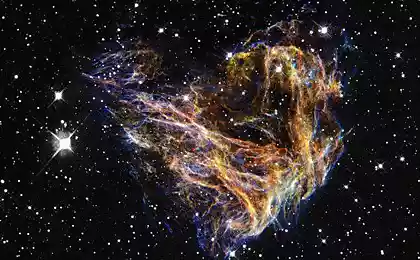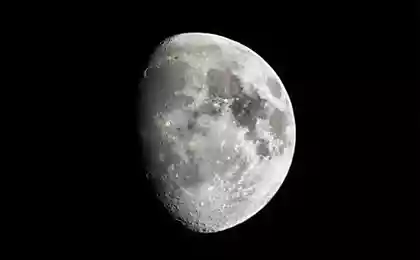1440
Space landscape of our planet
Was it a time when the Earth was ruled by giants and dragons, applying his magic on the ground, fighting for superiority and left such a mess? Could aliens visit these kingdoms use them in their tricky to? Of course, the scientists were able to find a plausible explanation for the unearthly landscape of our world. But they still did not find the reasons for their perfect symmetry, complex color palette, striking similarities with things made by human hands, or perhaps alien designs. They are surrounded by legends and mysteries, and who can say with confidence that there is - a fiction, and that - the real facts?
Here are the unique places on the planet that it seemed "not suitable." It seems that these impressive ethereal psychedelic landscapes appeared from somewhere in outer space, surrealistic painting, or a science fiction film. They - the main evidence that the imagination of mother nature is superior to our own.
1. The volcano Pu'u O'o-Hawaii
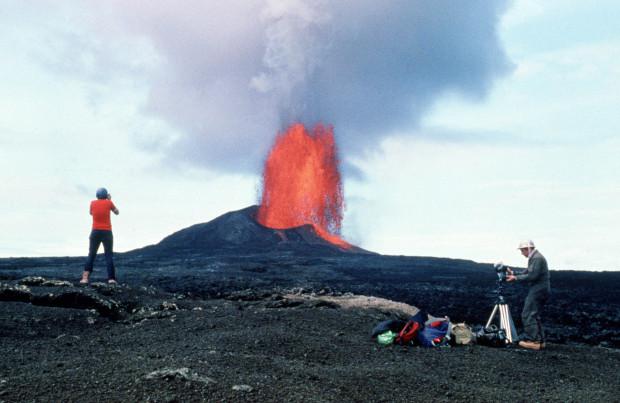
He became famous when he was recognized as the most active volcano in the last five centuries. Since 1983, he continually erupts, spilling 350 cubic kilometers of lava and covering nearly 130 square kilometers of land. Sometimes the lava thrown up to a height of 460 meter, creating an amazing spectacle.
Three years after its first eruption of lava flow reached ocean waters 16 km from the crater, forming the numerous lava tubes and impressive cloud of steam rises high above the ground. The most destructive eruption was in 1990, when the lava has covered two villages, destroying more than 100 homes. Hawaiian legends say about the Hawaiian goddess of volcanoes Pele, who uses her magic wand to open the volcano's mouth. O'o name just refers to this tool with the supernatural.
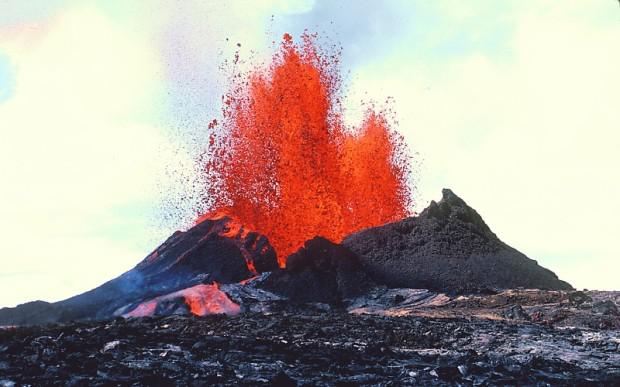
Despite the constant threat he represents, the volcano continues to fascinate researchers and attract many tourists and thrill seekers who want to look at something that looks like a bubbling primordial soup, ready to create new worlds.
2. Chocolate Hills in the Philippines
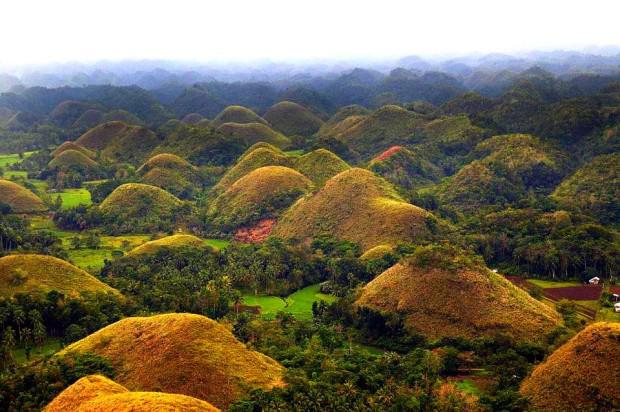
They are the same color as everyone's favorite dessert. Unfortunately, you can not eat the Chocolate Hills. This is not a huge mole mounds. Shaped perfect cone Chocolate Hills are in the list of the most bizarre and rare geological phenomena on Earth.
Nearly 80 square kilometers surface of Bohol, the tenth-largest island in the Philippines in 1268 covered these hills in height from 30 to 122 meters. They were formed about 2, 5 billion years ago, and there are several theories as to their origin. One says that these hills - the result of tectonic activity, move and climb the limestone deposits from the bottom of the sea, which once covered our world. But no one has been able to explain their perfect symmetry.
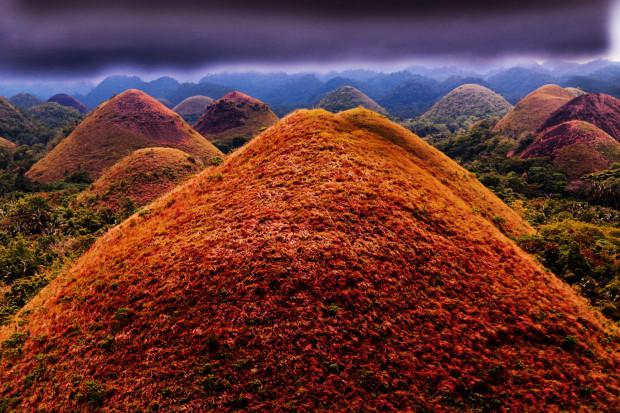
Usually covered with vegetation during the dry season and long periods of drought hills become chocolate brown. According to legend, the cones were created a long time ago, when the two giants fought in these lands, throwing stones and piles of sand at each other for several days in a row, leaving a big mess.
3. Mount Tiantsi China

It seems that these incredibly tall and slender mountains maintain your balance as a ballerina on pointe, even curious, they still have not collapsed. If they look familiar, it's because they inspired the soaring mountains of the planet Pandora in James Cameron (James Cameron) «Avatar». And they really make us think about the places where nature still lives in the world of people and all living beings.
Mountain Tiantsi in the Chinese province of Hunan formed under water about 380-million five years ago. The water has carved patiently soft sandstone, leaving only the hard rock in the middle, still standing as pointy towers, thus creating about 3,000 of these gigantic and impressive columns, which sometimes reach a height of 1220 meter above sea level, looking out of the mist as mysterious guards.

Tiantsi means "Son of Heaven" - the name for the unearthly extraterrestrial space. Tiantsi stretched on more than 16,550 acres of land. Thousands artistically shaped peaks, each standing higher than the other, old weathered spiers of quartz sandstone with its peaks covered with pine trees, admire the view of the dramatic scenery of massive blocks, obelisks and towers, waiting for our avatars to scout them.
4. Stone Forest in China Naygu
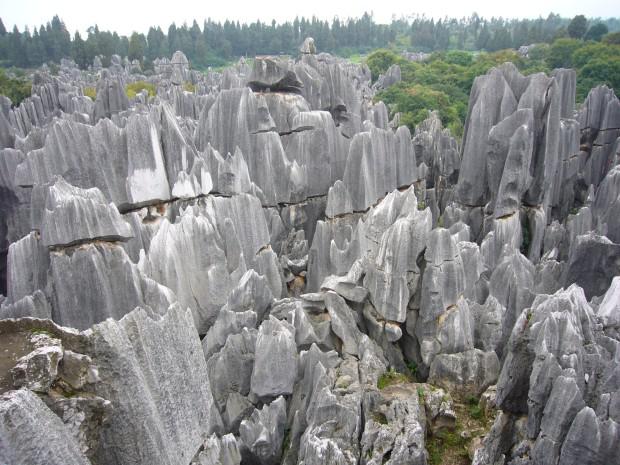
Covering an area of over 26 000 hectares, the Chinese stone forest covers most of the provinces of Guangxi, Yunnan and Guizhou. Stone Forest in Shilin Naygu, the most impressive part of Yunnan Province, boasts a variety of shapes and colors. Also known as the Black Stone Forest Shilin, or simply due to its proximity to the city of the same name, these amazing limestone formations grow out of the ground like calcified trees, creating the illusion of a unique stone forest or fossilized sea storm.
According to legend, this inhospitable place - the birthplace of Ashima, a beautiful girl, fell in love with a man for whom she was forbidden to marry. Terrible suffering, she turned to stone with a forest that surrounded her.

Formed as a result of the collapse of the limestone around 270 million five years ago, the karst landscape is shrouded in mysterious atmosphere like dark shadows fell on the unearthly spikes tower blocks and columns, resembling animals, portals and mushrooms, the highest of which reach 40 meters in height with lakes, caves and underground streams. Naygu translated means "ancient and black," a fitting name for one of the most mysterious places on the planet.
5. Wadi Rum in Jordan
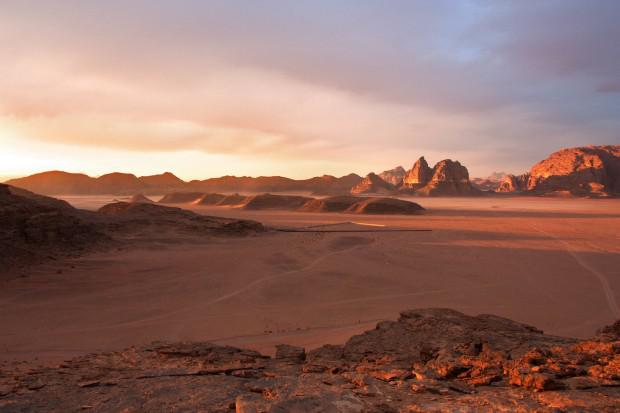
It is quite obvious why it is called the Valley of the Moon. Made famous by Lawrence of Arabia, Wadi Rum - a pink desert in southern Jordan, sprinkled high and pointy rocks among the large valleys, with unique sandstone formations: there are high cliffs, natural arches, ramps, spectacular caves and landslides.
Recognized natural and cultural sites by UNESCO narrow gorge of Wadi Rum witnessed more than 12 thousand years of human life with more than 25,000 rock carvings and 154 cultural monuments, offers a look at the evolution of the pastoral and agricultural activities in the area. It is home to the Bedouins with their large tents made of goat hair, have become the hallmark of this place, and Wadi Rum - a coveted destination for climbers and thrill-seekers come here to challenge the lonely peaks on the most difficult routes.
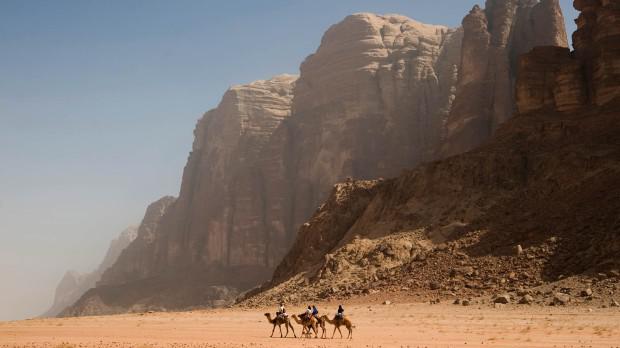
Impressive bright mixture of red sand and black basalt, Wadi Rum - the birthplace of the famous "Seven Pillars of Wisdom." While most believe that the novel TE Lawrence is named in honor of the bright formations of sandstone, the reality is just the opposite. Only in the last ten years it was adopted that name, but by careful counting, we find that there are only six pillars.
6. Eaglehawk Neck in Tasmania
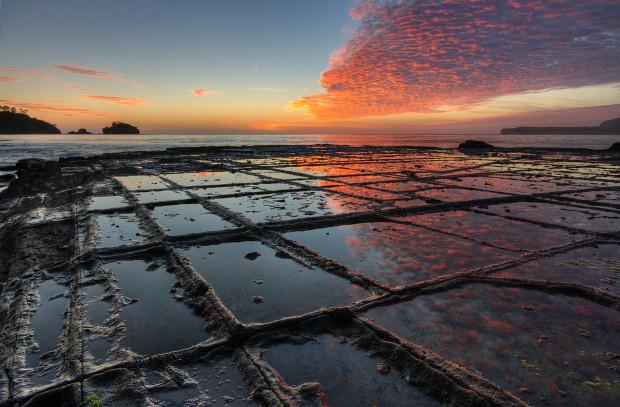
To the south of Tasmania, a narrow sandy isthmus connecting the Tasman Peninsula and the mainland. Eaglehawk Neck is known for two reasons. Firstly, it is an eloquent example of the extremely rare geological phenomenon called a mosaic pavement. Because of the erosion and fragmentation of rocks caused by the movement of tectonic plates, the earth looks as if it laid out hundreds of geometrically perfect rings very similar to artificial turf.
Secondly, Eaglehawk Neck tells a terrible story about the world's first dogs guarded prison. Dogs intentionally starved, that they become aggressive. A narrow piece of land was the only gate to freedom for British prisoners of Port Arthur. Prisoners had to overcome the 400 meters on the isthmus width of 30 meters. In addition to the guards, they would have to pass nine ferocious dogs, planted on the circuit at an equal distance from each other so that they could not reach each other, but to grab anyone who tries to pass them. The inmates were defenseless.
Plus, there are many legends, the waters are teeming with sharks, which would prevent an attempt to escape the ocean. Throughout the history of the prison, only three managed to escape in 1842. One of the escapees was the notorious Martin Cash.
7. Lake Hiller Australia
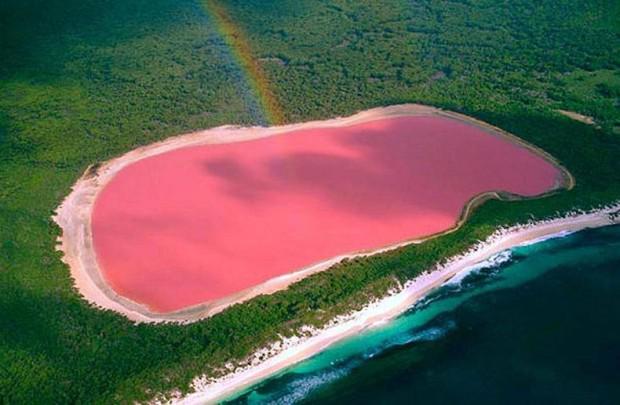
It's not a huge bubble gum and strawberry milkshake. It's only lake on the island of Middle Australia. However, it looks as if there shed a strange pink substance. It reaches a length of 600 meters the lake is separated from the ocean by Hiller narrow strip of land and is surrounded by a rim of white sand and dense forests, contrasting wonderfully with strange colored water in which exactly would want to swim aliens.
In the world there are other pink lakes, whose origins were explained. But in this case, it remains unclear on what is happening color of the lake. It has been proven that the color - it's not the play of light, since it remains bright enough even at water intake. Most plausible theory is the presence of dyes, created by micro-organisms (bacteria and algae) that live in the lake. There is no doubt that water is not harmful to humans. But as the water turned pink, it remains a mystery.
8. White Desert Sahara

Millions of years ago, when the dunes of the Sahara has been covered by the ocean, large deposits of chalk appeared on the sea floor, rubbed strange limestone formations. When the water receded, the wind formed this unusual form of chalk, which is why today it seems that the desert guarded by a giant white mushrooms.
Sahara el Beida, as they call it the locals, or simply the White Desert, located in close proximity to Faraffa oasis in the Libyan desert, is home to a unique geological phenomenon. Strange shapes of soft chalk white and cream color continues to change under the chisels wind.
Faraffa Oasis, one of the smallest and most remote settlements in Egypt, has no more than 4,000 inhabitants and is located 180 kilometers from the nearest settlement. Despite this, a large number of tourists every year visit it. One of the many legends about this place is connected with the mysterious disappearance of the army of Cambyses, the Persian king who conquered Egypt VI-th century BC. e. Can these fossilized guards to be soldiers of his army?
9. Dedvley Namibia
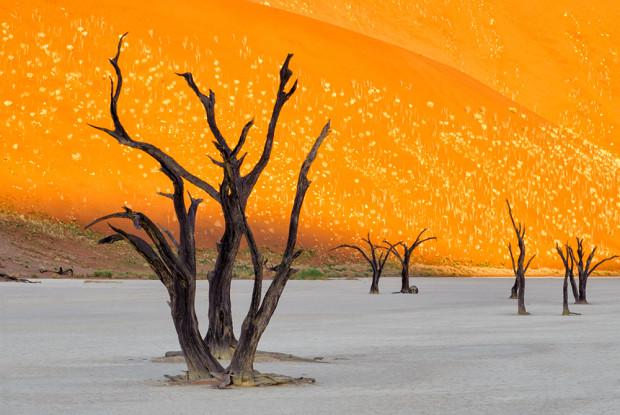
Do not be fooled. This is not a surrealist painting, and you can be sure that on Mars there are no trees. This is nothing more than wonderful work of nature. Coal black parched trees stand in the background elevated the world's largest sand dunes.
Once I passed through Dedvley river. Over time, the river dried up, leaving it dry and lifeless place. Skeletons of trees reminiscent of the once dense forest are the former, as if to say that the world around us can change in a split second. Santa Pour means "swamp" or "lake". A better name for this place just did not find. Now it is a huge cemetery for more than 900-year-old trees, still standing high, like sentinels in the barren desert, though devoid of life, but incredibly beautiful.
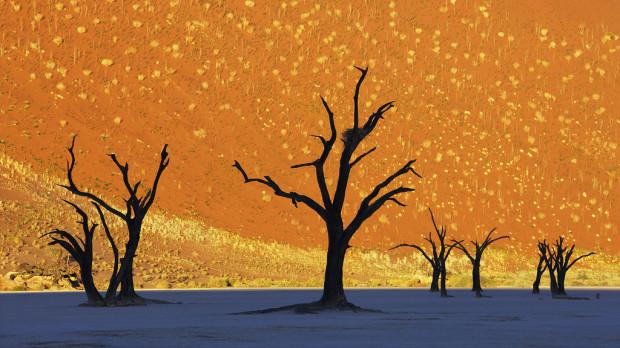
Park "Namib Naukluft," in Namibia - is home to the world's highest sand dunes, some of which reach 400 meters in height. Trees in the desert are very unusual. Hundreds of dead acacia trees with twisted and crooked branches were completely mummified they froze because the surrounding conditions do not allow them to decompose.
10. Eye of the Sahara

Craters of the Moon seems to have become a little closer. They are at the heart of the Sahara Desert, to be precise. Richat Structure in Mauritania, commonly known as the Eye or Eye of the Sahara in Africa, continues to fascinate researchers and scientists from all over the globe. Recognized as one of the biggest mysteries of the planet, a giant, very symmetrical eroded bowl was accidentally seen by astronauts when they took pictures of the desert.
At first everyone believed that the unusual geological formation - a trace of a meteorite collision, mainly due to the huge size - about 45 km in diameter. Others believe that it is the result of volcanic activity. In the end, the researchers came to the unequivocal conclusion that Richat Structure - is the result of a natural phenomenon, namely the rise of the dome, exposed to wind erosion, over time, cut the very mother nature. However, they can not explain what made equidistant from the center of the ring. Bull's-eye of the Earth remains a mystery, surrounded by countless myths and hypotheses.
©
Here are the unique places on the planet that it seemed "not suitable." It seems that these impressive ethereal psychedelic landscapes appeared from somewhere in outer space, surrealistic painting, or a science fiction film. They - the main evidence that the imagination of mother nature is superior to our own.
1. The volcano Pu'u O'o-Hawaii

He became famous when he was recognized as the most active volcano in the last five centuries. Since 1983, he continually erupts, spilling 350 cubic kilometers of lava and covering nearly 130 square kilometers of land. Sometimes the lava thrown up to a height of 460 meter, creating an amazing spectacle.
Three years after its first eruption of lava flow reached ocean waters 16 km from the crater, forming the numerous lava tubes and impressive cloud of steam rises high above the ground. The most destructive eruption was in 1990, when the lava has covered two villages, destroying more than 100 homes. Hawaiian legends say about the Hawaiian goddess of volcanoes Pele, who uses her magic wand to open the volcano's mouth. O'o name just refers to this tool with the supernatural.

Despite the constant threat he represents, the volcano continues to fascinate researchers and attract many tourists and thrill seekers who want to look at something that looks like a bubbling primordial soup, ready to create new worlds.
2. Chocolate Hills in the Philippines

They are the same color as everyone's favorite dessert. Unfortunately, you can not eat the Chocolate Hills. This is not a huge mole mounds. Shaped perfect cone Chocolate Hills are in the list of the most bizarre and rare geological phenomena on Earth.
Nearly 80 square kilometers surface of Bohol, the tenth-largest island in the Philippines in 1268 covered these hills in height from 30 to 122 meters. They were formed about 2, 5 billion years ago, and there are several theories as to their origin. One says that these hills - the result of tectonic activity, move and climb the limestone deposits from the bottom of the sea, which once covered our world. But no one has been able to explain their perfect symmetry.

Usually covered with vegetation during the dry season and long periods of drought hills become chocolate brown. According to legend, the cones were created a long time ago, when the two giants fought in these lands, throwing stones and piles of sand at each other for several days in a row, leaving a big mess.
3. Mount Tiantsi China

It seems that these incredibly tall and slender mountains maintain your balance as a ballerina on pointe, even curious, they still have not collapsed. If they look familiar, it's because they inspired the soaring mountains of the planet Pandora in James Cameron (James Cameron) «Avatar». And they really make us think about the places where nature still lives in the world of people and all living beings.
Mountain Tiantsi in the Chinese province of Hunan formed under water about 380-million five years ago. The water has carved patiently soft sandstone, leaving only the hard rock in the middle, still standing as pointy towers, thus creating about 3,000 of these gigantic and impressive columns, which sometimes reach a height of 1220 meter above sea level, looking out of the mist as mysterious guards.

Tiantsi means "Son of Heaven" - the name for the unearthly extraterrestrial space. Tiantsi stretched on more than 16,550 acres of land. Thousands artistically shaped peaks, each standing higher than the other, old weathered spiers of quartz sandstone with its peaks covered with pine trees, admire the view of the dramatic scenery of massive blocks, obelisks and towers, waiting for our avatars to scout them.
4. Stone Forest in China Naygu

Covering an area of over 26 000 hectares, the Chinese stone forest covers most of the provinces of Guangxi, Yunnan and Guizhou. Stone Forest in Shilin Naygu, the most impressive part of Yunnan Province, boasts a variety of shapes and colors. Also known as the Black Stone Forest Shilin, or simply due to its proximity to the city of the same name, these amazing limestone formations grow out of the ground like calcified trees, creating the illusion of a unique stone forest or fossilized sea storm.
According to legend, this inhospitable place - the birthplace of Ashima, a beautiful girl, fell in love with a man for whom she was forbidden to marry. Terrible suffering, she turned to stone with a forest that surrounded her.

Formed as a result of the collapse of the limestone around 270 million five years ago, the karst landscape is shrouded in mysterious atmosphere like dark shadows fell on the unearthly spikes tower blocks and columns, resembling animals, portals and mushrooms, the highest of which reach 40 meters in height with lakes, caves and underground streams. Naygu translated means "ancient and black," a fitting name for one of the most mysterious places on the planet.
5. Wadi Rum in Jordan

It is quite obvious why it is called the Valley of the Moon. Made famous by Lawrence of Arabia, Wadi Rum - a pink desert in southern Jordan, sprinkled high and pointy rocks among the large valleys, with unique sandstone formations: there are high cliffs, natural arches, ramps, spectacular caves and landslides.
Recognized natural and cultural sites by UNESCO narrow gorge of Wadi Rum witnessed more than 12 thousand years of human life with more than 25,000 rock carvings and 154 cultural monuments, offers a look at the evolution of the pastoral and agricultural activities in the area. It is home to the Bedouins with their large tents made of goat hair, have become the hallmark of this place, and Wadi Rum - a coveted destination for climbers and thrill-seekers come here to challenge the lonely peaks on the most difficult routes.

Impressive bright mixture of red sand and black basalt, Wadi Rum - the birthplace of the famous "Seven Pillars of Wisdom." While most believe that the novel TE Lawrence is named in honor of the bright formations of sandstone, the reality is just the opposite. Only in the last ten years it was adopted that name, but by careful counting, we find that there are only six pillars.
6. Eaglehawk Neck in Tasmania

To the south of Tasmania, a narrow sandy isthmus connecting the Tasman Peninsula and the mainland. Eaglehawk Neck is known for two reasons. Firstly, it is an eloquent example of the extremely rare geological phenomenon called a mosaic pavement. Because of the erosion and fragmentation of rocks caused by the movement of tectonic plates, the earth looks as if it laid out hundreds of geometrically perfect rings very similar to artificial turf.
Secondly, Eaglehawk Neck tells a terrible story about the world's first dogs guarded prison. Dogs intentionally starved, that they become aggressive. A narrow piece of land was the only gate to freedom for British prisoners of Port Arthur. Prisoners had to overcome the 400 meters on the isthmus width of 30 meters. In addition to the guards, they would have to pass nine ferocious dogs, planted on the circuit at an equal distance from each other so that they could not reach each other, but to grab anyone who tries to pass them. The inmates were defenseless.
Plus, there are many legends, the waters are teeming with sharks, which would prevent an attempt to escape the ocean. Throughout the history of the prison, only three managed to escape in 1842. One of the escapees was the notorious Martin Cash.
7. Lake Hiller Australia

It's not a huge bubble gum and strawberry milkshake. It's only lake on the island of Middle Australia. However, it looks as if there shed a strange pink substance. It reaches a length of 600 meters the lake is separated from the ocean by Hiller narrow strip of land and is surrounded by a rim of white sand and dense forests, contrasting wonderfully with strange colored water in which exactly would want to swim aliens.
In the world there are other pink lakes, whose origins were explained. But in this case, it remains unclear on what is happening color of the lake. It has been proven that the color - it's not the play of light, since it remains bright enough even at water intake. Most plausible theory is the presence of dyes, created by micro-organisms (bacteria and algae) that live in the lake. There is no doubt that water is not harmful to humans. But as the water turned pink, it remains a mystery.
8. White Desert Sahara

Millions of years ago, when the dunes of the Sahara has been covered by the ocean, large deposits of chalk appeared on the sea floor, rubbed strange limestone formations. When the water receded, the wind formed this unusual form of chalk, which is why today it seems that the desert guarded by a giant white mushrooms.
Sahara el Beida, as they call it the locals, or simply the White Desert, located in close proximity to Faraffa oasis in the Libyan desert, is home to a unique geological phenomenon. Strange shapes of soft chalk white and cream color continues to change under the chisels wind.
Faraffa Oasis, one of the smallest and most remote settlements in Egypt, has no more than 4,000 inhabitants and is located 180 kilometers from the nearest settlement. Despite this, a large number of tourists every year visit it. One of the many legends about this place is connected with the mysterious disappearance of the army of Cambyses, the Persian king who conquered Egypt VI-th century BC. e. Can these fossilized guards to be soldiers of his army?
9. Dedvley Namibia

Do not be fooled. This is not a surrealist painting, and you can be sure that on Mars there are no trees. This is nothing more than wonderful work of nature. Coal black parched trees stand in the background elevated the world's largest sand dunes.
Once I passed through Dedvley river. Over time, the river dried up, leaving it dry and lifeless place. Skeletons of trees reminiscent of the once dense forest are the former, as if to say that the world around us can change in a split second. Santa Pour means "swamp" or "lake". A better name for this place just did not find. Now it is a huge cemetery for more than 900-year-old trees, still standing high, like sentinels in the barren desert, though devoid of life, but incredibly beautiful.

Park "Namib Naukluft," in Namibia - is home to the world's highest sand dunes, some of which reach 400 meters in height. Trees in the desert are very unusual. Hundreds of dead acacia trees with twisted and crooked branches were completely mummified they froze because the surrounding conditions do not allow them to decompose.
10. Eye of the Sahara

Craters of the Moon seems to have become a little closer. They are at the heart of the Sahara Desert, to be precise. Richat Structure in Mauritania, commonly known as the Eye or Eye of the Sahara in Africa, continues to fascinate researchers and scientists from all over the globe. Recognized as one of the biggest mysteries of the planet, a giant, very symmetrical eroded bowl was accidentally seen by astronauts when they took pictures of the desert.
At first everyone believed that the unusual geological formation - a trace of a meteorite collision, mainly due to the huge size - about 45 km in diameter. Others believe that it is the result of volcanic activity. In the end, the researchers came to the unequivocal conclusion that Richat Structure - is the result of a natural phenomenon, namely the rise of the dome, exposed to wind erosion, over time, cut the very mother nature. However, they can not explain what made equidistant from the center of the ring. Bull's-eye of the Earth remains a mystery, surrounded by countless myths and hypotheses.
©









